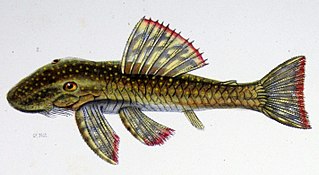
Lasiancistrus is a genus of suckermouth armored catfishes. They are native to South America and Panama.
Ancistrus hoplogenys is a species of armored catfish native to Argentina, Brazil, Guyana, Paraguay, Peru, and Uruguay, where it occurs in the basins of the Amazon River, the Essequibo River, and the Paraguay River. It has also been reported from Suriname. This species grows to a length of 15.8 centimetres (6.2 in) SL. In the aquarium hobby, this fish is sometimes known as the spotted or starlight bristlenose pleco, although it may also be referred to by its L-number, which is L059.

Ancistrus caucanus is a species of catfish in the family Loricariidae. It is native to South America, where it was at one point thought to occur in the Cauca River basin in Colombia, for which it is named, although subsequent research suggested in 2013 that it is actually native to the Magdalena River basin, whereas its congener Ancistrus vericaucanus is the species native to the Cauca. The species reaches 5.2 cm SL. It is not to be confused with the similarly named species Lasiancistrus caucanus.
Ancistrus sericeus is a species of catfish in the family Loricariidae. It is native to South America, where it occurs in the basin of the Ampiyacu River, a tributary of the Amazon River, in Peru. The species reaches 5 cm SL.
Ancistrus chagresi is a species of catfish in the family Loricariidae. It is native to Central America, where it occurs near the Panama Canal in the basins of the Chagres River, the Chorrera River, and the Gatún River. The species reaches 19.5 cm SL.
Ancistrus parecis is a species of catfish in the family Loricariidae. It is native to South America, where it occurs in the Tapajós River basin in Brazil. Its specific epithet refers to the Parecis Plateau, where the type specimen was collected. The species reaches 6 cm SL.
Ancistrus amaris is a species of catfish in the family Loricariidae. It is native to South America, where it occurs in the Orinoco River and Apure River basins in Venezuela. The species reaches at least 11.57 cm SL and was described in 2019 by Lesley S. de Souza of the Field Museum of Natural History, Donald C. Taphorn of the Royal Ontario Museum, and Jonathan Armbruster of Auburn University alongside five other species of Ancistrus. FishBase does not list this species.
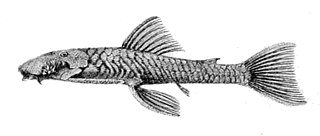
Ancistrus greeni is a species of catfish in the family Loricariidae. It is native to South America, where it occurs in the Madre de Dios River and Inambari River basins in Peru. The species reaches 6.5 cm in total length.
Ancistrus saudades is a species of catfish in the family Loricariidae. It is native to South America, where it occurs in the basins of the Takutu River, the Ventuari River, the Caroní River, and the Caura River in Guyana, Venezuela, and Brazil. The species reaches at least 10.75 cm SL and was described in 2019 by Lesley S. de Souza of the Field Museum of Natural History, Donald C. Taphorn of the Royal Ontario Museum, and Jonathan Armbruster of Auburn University alongside five other species of Ancistrus. FishBase does not list this species.
Ancistrus yutajae is a species of catfish in the family Loricariidae. It is native to South America, where it occurs only in the Yutajé River in Venezuela. The species reaches at least 8.28 cm SL and was described in 2019 by Lesley S. de Souza of the Field Museum of Natural History, Donald C. Taphorn of the Royal Ontario Museum, and Jonathan Armbruster of Auburn University alongside five other species of Ancistrus. FishBase does not list this species.
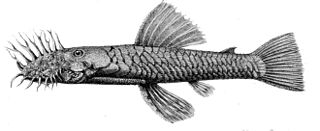
Ancistrus montanus is a species of catfish in the family Loricariidae. It is native to South America, where it occurs in high-altitude freshwater environments, with the type specimen being collected from an elevation of around 457 m, in the Beni River basin in the upper Madeira River drainage in Bolivia. The species reaches 9.2 cm SL.
Ancistrus heterorhynchus is a species of catfish in the family Loricariidae. It is native to South America, where it occurs in the Inambari River basin, which is part of the Madre de Dios River drainage in Peru. The species reaches 6.3 cm SL and is known to inhabit high-altitude areas.
Ancistrus malacops is a species of catfish in the family Loricariidae. It is a freshwater fish native to South America, where it occurs in the Ampiyacu River basin in Peru. FishBase states that the species reaches 7.7 cm SL, although larger specimens, including one of 11.78 cm SL from the Gustavo Orcés V. Natural History Museum in Quito, Ecuador, are known.
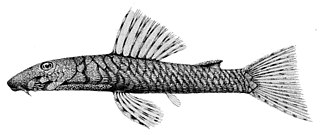
Ancistrus marcapatae is a species of catfish in the family Loricariidae. It is native to South America, where it occurs in the Inambari River basin, which is part of the Madeira River drainage in Peru. The species reaches 12.4 cm in total length.
Ancistrus megalostomus is a species of catfish in the family Loricariidae. It is native to South America, where it occurs in the Beni River basin, which is part of the Madeira River drainage in Bolivia. The species reaches 8.3 cm SL and is noted to inhabit high-altitude environments.
Ancistrus occloi is a species of catfish in the family Loricariidae. It is a freshwater fish native to South America, where it occurs in the Urubamba River basin in Peru. The species reaches 11.6 cm SL and is noted to inhabit high-altitude areas.
Ancistrus reisi is a species of catfish in the family Loricariidae. It is a freshwater fish native to South America, where it is known to occur in small rivers in the state of Tocantins in Brazil. The species reaches 6.1 cm SL and is distinguished from most members of the genus by the absence of an adipose fin, which for this species is replaced by a series of unpaired platelets that form a low crest.
Ancistrus tolima is a species of catfish in the family Loricariidae. It is native to South America, where it occurs in the Magdalena River drainage, which is part of the Prado River basin in Colombia. The species reaches 7.7 cm SL. Its specific epithet is a reference to Colombia's Tolima Department, which contains the type locality of the species.
Ancistrus verecundus is a species of catfish in the family Loricariidae. It is native to South America, where it occurs in the Madeira River basin in Brazil. The species reaches 5.5 cm SL. Its specific epithet, verecundus, derives from Latin and means "modest" or "bashful", referencing the absence or reduced presence of tentacles on the snout of the species.
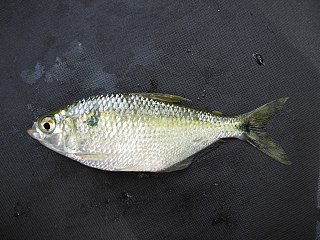
Astyanax caucanus is a small species of freshwater fish only found in Colombia. While little research exists regarding its ecological habits, such as diet and mating practices, its environment preferences are known to include marshy lowlands, and it easily lives in sympatry with various other fish species in the Cauca and Magdalena river basins. It is not known to share a habitat with any other species of Astyanax, but has a noted phyletic relationship to a group of congeners including Astyanax filiferus, Astyanax stilbe, and Astyanax magdalenae.






